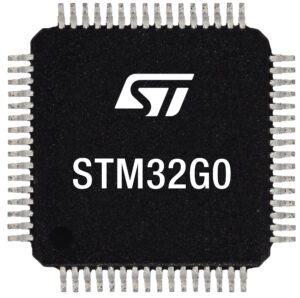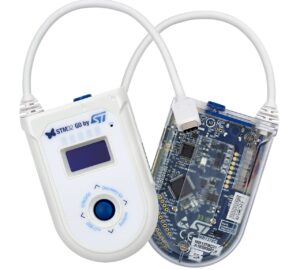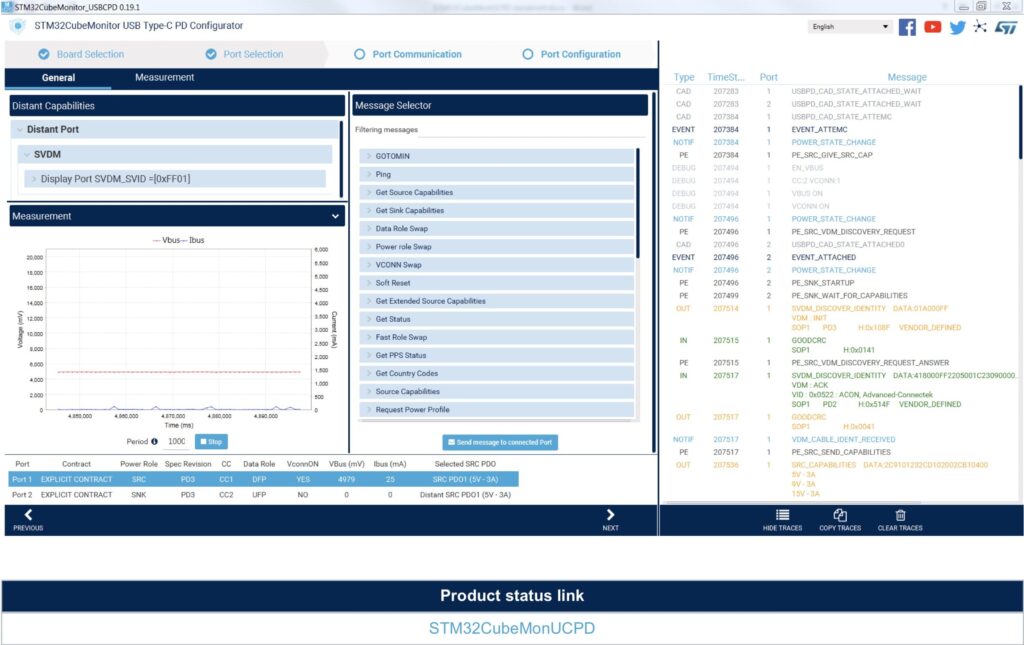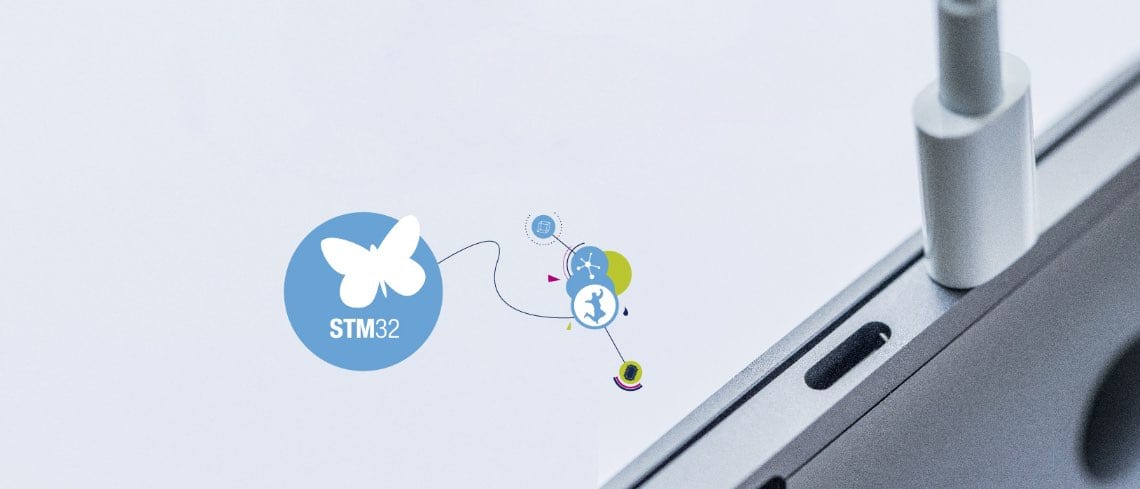We are launching today a complete USB-C Power Delivery (PD) ecosystem. It means updates to the STM32G0’s firmware, on top of its evaluation board (STM32G081B-EVAL) and the STM32CubeMX utility, as well as the commercial availability of a new STM32GO Discovery Kit, and the deployment of our new STM32CubeMonitor-UCPD. This broad and unique initiative will enable developers to become familiar with the latest standards of the USB Implementers Forum (USB-IF). From there, they can start creating their USB-C PD applications to update their current designs or come up with a new one, thanks to original tools that will facilitate the process and reduce their time to market.
With the launch of the STM32G0 a few months ago, our first 90-nm mainstream MCU, ST was also the first in the industry to offer a general-purpose microcontroller with two USB-C PD (or UCPD) interfaces. It meant that designers no longer needed an external PD controller, thus simplifying the PCB designs, lowering the bill of materials, and offering many more features than with a traditional controller. With this wave of updates and launches, we are now standing next to our partners to make it easier than ever to take advantage of these new standards and protocols. Because the USB-C PD protocol can handle power transfers of up to 100 W, the connector is gaining grounds in all sorts of new industrial and prosumer markets, which is why we offer code examples and tools to assist engineers, regardless of their background.
Use STM32CubeMX to Implement Fast Role Swap

A popular feature of the USB-C PD standard is Dual Role Port (or DRP), which means that the same USB-C connector can act as a source (sending power), or as a sink, (receiving power from the source). However, the STM32G0 is groundbreaking because it implements all the standard and optional features of the Power Delivery 3.0 protocol. For instance, Fast Role Swap goes a step beyond DRP by enabling a USB-C PD system to switch from sink to a source, or vice versa, in less than 150 µs. Let’s take a user that connects a laptop to a hub to charge the computer and output a video signal to a display. If someone trips over the hub’s power cord, the PC can use fast role swap to switch from sink to source very rapidly to power the hub, which will continue to send the video signal without any interruption.
To help engineers integrate all these optional features we are updating our STM32CubeG0 firmware and our STM32CubeMX utility to provide drivers, libraries, example applications, and source codes. For instance, STM32CubeMX has a graphical user interface to help engineers define the role of each of their USB-C ports (sink, source, or dual), with just a few clicks. The system then generates header files and developers need to include them into their application, bypassing complex operations and hours of documentation. Our libraries also assist developers in the implementation of functionalities like Fast Role Swap, which means that as long as they follow our designs and codes, they will be able to offer the latest features to their final users relatively quickly and efficiently.
Try the STM32G0 Discovery Kit to Test Alternate Mode

Another optional feature of the USB-C PR protocol that we provide with the STM32G0 UCPD interface is the alternate modes or Alt-Modes. Very simply, it repurposes the data line of the USB connector to send non-USB signals, such as a video, an Ethernet packet, or a high-speed link like Thunderbolt 3. For example, a manufacturer can now more easily create a dock for a video game console or smartphone that connects to a television. The USB-C port will deliver power to the gaming machine or phone, but it will also manage HDMI requests from a TV, thus enabling the use of only one cable to enjoy all these features.
The problem is that manufacturers don’t always clearly indicate if their device support alt-mode. A design may also have more than one USB-C, but only one of them is compatible with the feature. It was thus crucial for us to release STM32G0 USB-C Discovery, a kit that can connect to a USB-C Port and detect its role, its power information, and whether it is compatible with Alternate Mode. Even an engineer with minimal experience with this new protocol can plug the kit and use the “Standalone Mode” to get crucial information. We also offer a “Sniffer and USB PD Meter Mode” that enables the equipment to sit between two USB-C devices to display voltage and current direction and information. Testing a setup has never been easier.
Launch STM32CubeMonitor-UCPD To Try Vendor Defined Messages and Power Profiles

The new STM32G0 Discovery kit also has a third mode called “Advanced User,” which will delight developers who want to load applications, debug their code, or configure their USB-C system. And to make our kit even more powerful, ensuring compatibility with STM32CubeMonitor-UCPD, a new software, and monitoring tool, that works with all our USB-C PD interfaces and libraries, and that helps engineers test and implement major Power Delivery 3.0 functionalities. Its GUI provides an interface to track current, voltage, and messages between the sink and the source. It’s even possible to configure Vendor Defined Messages, a feature that enables a manufacturer to request information that isn’t part of the USB specification. For instance, a VDM can ask for the temperature of a component, and with our software, engineers can tailor their USB-C application to distinguish themselves from the rest of the competition.
Engineers will enjoy the fact that they can set up multiple power profiles, right from STM32CubeMonitor-UCPD, to adjust the device’s behavior based on the charger that the user connects to the system. They can even go one step further and use the STM32G0 to implement USB-C Authentication (or C-AUTH). It enables a product to ask a cable or the device at the other end to provide electrical characteristics, or an XID, which certifies that it passed USB-C IF certifications. If they are absent or incompatible, the system can stop charging operations. We noticed that this feature was particularly popular among some of our customers. For instance, e-Cigarette makers want to prevent the use of cheap alternatives because a malfunction can have catastrophic results if they happen while the user is carrying their device.
Jump on the Bandwagon with ST’S USB-C PD Ecosystem
ST is today the only company to provide such a vast and accessible set of tools to take advantage of all that USB-C PD 3.0 has to offer. And we will also continue to update our hardware and software. Over time, users can expect new applications and packs. Additionally, we will also launch STM32G0s with a USB-C interface for data and power during the first half of 2020, as announced when we launched the MCU. Currently, STM32G0 primarily targets low-power applications that want an all-in-one system to reduce costs while implementing more features. These applications only use a USB-C connector for power and find the right performance-per-dollar ratio in the current models. As we launch more powerful versions of the STM32G0, we will, nevertheless, adjust our hardware to accommodate the new designs that will benefit from these beefier MCUs.
- Learn more about STM32G0
- Check out the STM32G081B-EVAL evaluation board
- Try out STM32CubeMX
- Teach yourself USB-C with our STM32GO Discovery Kit
- Enjoy STM32CubeMonitor-UCPD
- Get an overview of the STM32G0 USB-C PD Ecosystem with its Press Release
